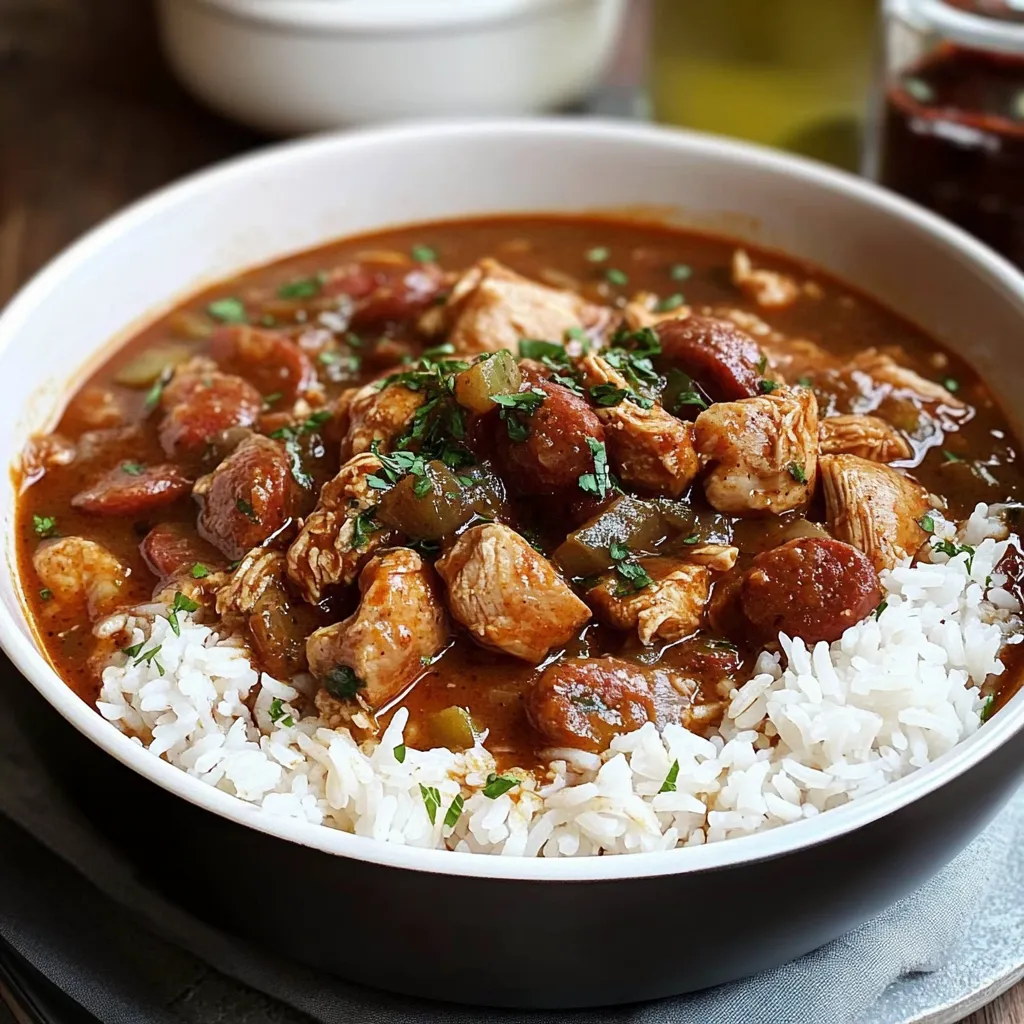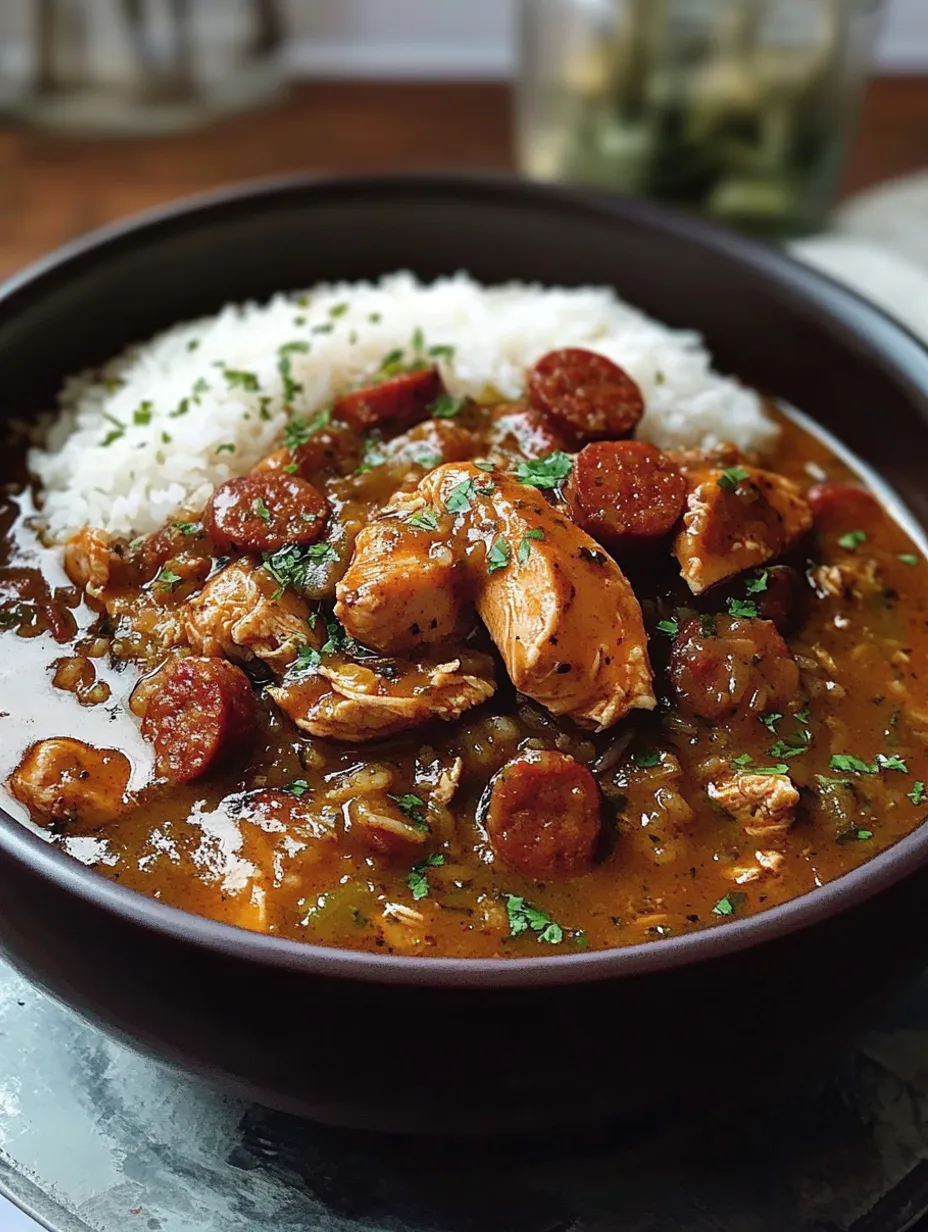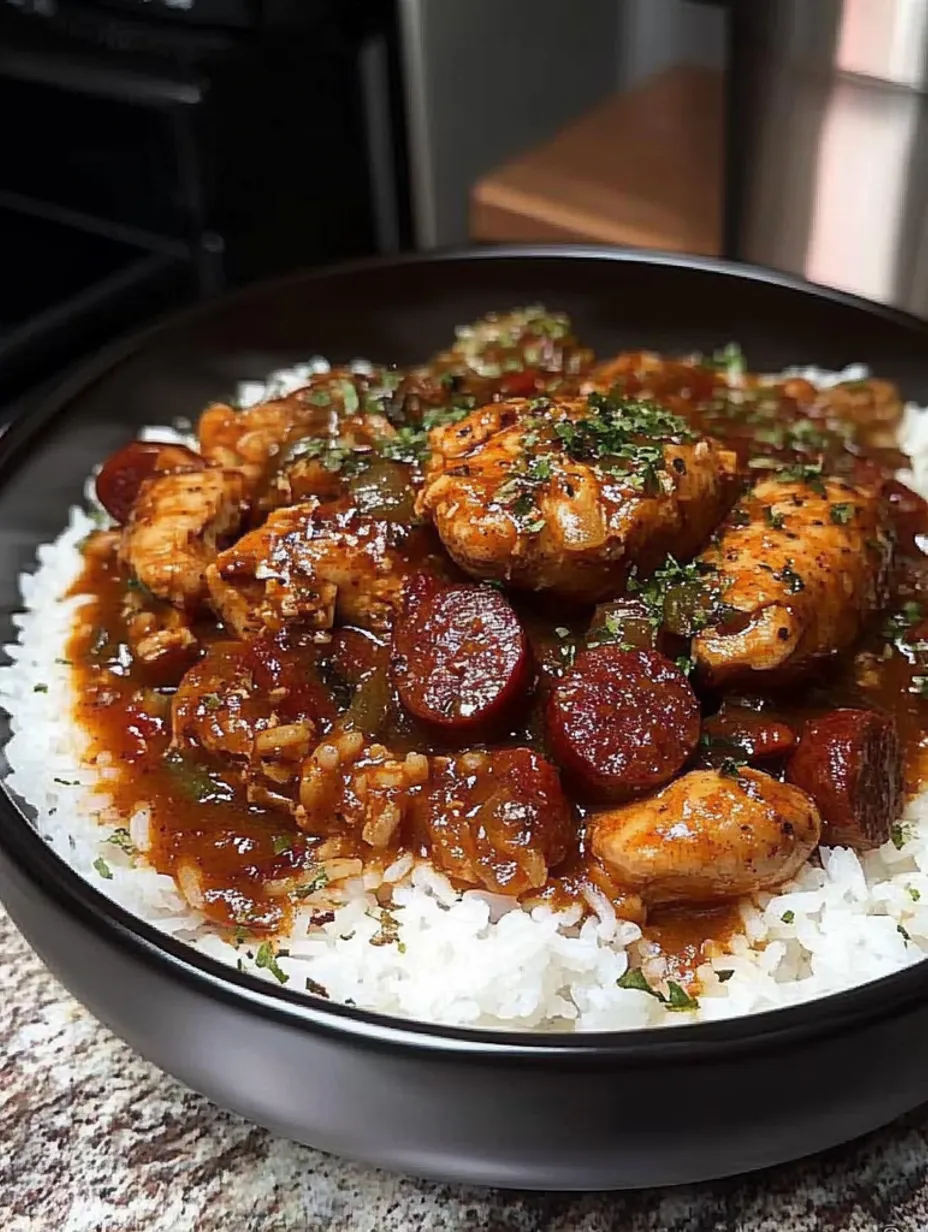 Pin it
Pin it
Let me tell you about this Cajun Chicken & Sausage Gumbo that's become my go-to comfort food. It's this incredible Louisiana dish that just warms you from the inside out. I've been tweaking this recipe for years, and it's all about that dark chocolate-colored roux, tender chicken thighs, and spicy andouille sausage swimming in a broth that's packed with so much flavor it'll make your taste buds dance. Just ladle it over some fluffy white rice and you've got yourself a meal that'll make anyone think you've got Cajun roots.
Last year when my husband's brother visited from New Orleans, I nearly had a panic attack making this for him. I mean, the guy grew up eating authentic gumbo! When he took his first bite, he got really quiet, and I was mentally preparing my apology speech. Then he looked up with this surprised expression and said, "This tastes like home." I think I floated around the kitchen for days after that. Turns out the secret was not rushing that darn roux. Who knew standing at a stove stirring for 20 minutes straight could be so rewarding?
Key Ingredients
Chicken Thighs - Don't even think about using chicken breast here. Thighs have more flavor and stay juicy through the long cooking. I tried it with breast meat once and everyone could tell something was "off." Just trust me on this one.
Andouille Sausage - This stuff brings the smoky, spicy backbone. Try to find the good stuff with visible spices in it. One time I could only find kielbasa and while it worked okay, it just wasn't the same. The real deal andouille adds that authentic punch.
The Holy Trinity - That's what Cajuns call the combo of onion, bell pepper, and celery. My grandmother would roll in her grave if I skipped any of these three. I've tried changing the ratios but equal parts really does work best.
The Roux - This is where gumbo lives or dies. It's just flour and oil, but cooking it until it's the color of dark chocolate takes patience. My first attempt I got scared and stopped at tan. Big mistake! That deep nutty flavor only comes from taking it almost to the edge.
Cajun Seasoning - I keep a jar of Tony Chachere's in my pantry, but sometimes mix my own. My neighbor makes hers way too salty, and I've had others that are nothing but red pepper. Balance is key here.
 Pin it
Pin it
Making Perfect Gumbo
Rice FirstI always start with the rice because it's easy to keep warm while the gumbo finishes. Rinse your rice really well - I stick it in a strainer and run cold water through until it's not cloudy anymore. Dump 2 cups of rice in a pot with 4 cups water and a good pinch of salt. Bring it to a boil, then immediately turn it down to a simmer and cover it. Set a timer for exactly 15 minutes (seriously, be precise here). When it beeps, don't peek! Just turn off the heat and let it sit covered for another 5 minutes. Fluff it with a fork when you're ready to serve.
The Sacred RouxGet yourself a heavy pot - I use my grandma's old cast iron Dutch oven but any heavy-bottomed pot works. Heat up 1/2 cup of vegetable oil until it's shimmering but not smoking. Sprinkle in 1/2 cup of flour while whisking like your life depends on it. Now comes the arm workout - keep stirring constantly for about 15-20 minutes. It'll go from white to blonde to peanut butter to milk chocolate and finally to that dark chocolate color you want. My first time, I got distracted by a text and had to throw everything out and start over. A burnt roux is useless, so don't take your eyes off it!
Add Your TrinityOnce your roux is that beautiful dark brown color, throw in your chopped onion, bell pepper, and celery all at once. It'll sizzle and stop the roux from getting any darker. Stir everything around for about 5 minutes until the veggies soften up. They'll soak up all that roux flavor and start to smell amazing. Toss in the garlic for just 30 seconds at the end - any longer and it'll burn and get bitter. The whole kitchen should smell like heaven at this point.
Meat MagicNow toss in those slices of andouille sausage. Let them get a bit of color as they hang out with the veggies. The fat from the sausage will start to release, and that's where so much flavor lives. After a couple minutes, add your chicken pieces and stir everything around so the meat gets coated in all that flavorful roux mixture. I've tried adding the meat in different orders, and this way just works better for developing layers of flavor.
Liquid LoveThis part always makes me nervous - adding the liquid to the roux. Pour in your chicken broth slowly while stirring constantly. I've had lumpy gumbo before and it's not cute. Once the broth is incorporated, add in your Worcestershire sauce, tomatoes (if you're using them - they're controversial in gumbo circles), and all your seasonings - the Cajun spice blend, smoked paprika, thyme, and those bay leaves. Season with salt and pepper, but go easy since many Cajun seasoning blends already have salt. Bring everything up to a gentle boil.
The Waiting GameNow turn down the heat to a simmer. I mean a real simmer - just little bubbles breaking the surface. Let it go for at least 45 minutes, but honestly, the longer the better. My best batch ever simmered for nearly 3 hours. Stir it occasionally so nothing sticks to the bottom. You'll notice it starting to thicken up as the roux works its magic. The chicken will get more tender, the sausage will give up more flavor, and everything just melds together. This is why gumbo isn't a weeknight meal for me - you can't rush this part.
Finishing TouchesWhen you're just about ready to eat, fish out those bay leaves - nobody wants to bite into one of those. Stir in most of your chopped green onions and parsley, saving some for garnishing bowls. Taste it one more time to see if it needs more salt or pepper. The flavor should be rich and complex, with a bit of heat from the sausage and Cajun seasoning.
The first time I attempted roux I was so paranoid about burning it that I probably stopped five shades too early. The gumbo was kinda bland, and I couldn't figure out why until I saw a proper dark roux at my friend Lisa's house. She actually laughed at my description of "peanut butter colored" and said, "Honey, you need to get braver with your roux!" She stood right next to me the next time, pushing me to keep going when I would have stopped. That extra cooking time made ALL the difference - suddenly my gumbo had this deep, nutty flavor I'd been missing. Now my teenagers know not to bother me during "roux time" - those 20 minutes are sacred in our house.
Perfect Pairings
This gumbo is perfect ladled over a mound of that fluffy white rice in big, wide bowls. I like to put the rice in first, then pour the gumbo around it so you get this island of white in a sea of rich, dark deliciousness. You absolutely need some good crusty French bread on the side - storebought is fine, but I sometimes make a quick no-knead loaf if I'm feeling ambitious. There's nothing better than using that bread to sop up the last bits of gumbo from your bowl. A simple green salad with a tangy vinaigrette works perfectly alongside since it cuts through all that richness. Nothing fancy - just some mixed greens, maybe some cucumber and tomato, with a sharp dressing. When my Louisiana relatives visit, they insist on having hot sauce on the table too. Crystal is traditional, but use whatever you like. Whenever we have this for dinner, I serve cold beer for the adults - Abita if I can find it to keep the Louisiana theme going. For the kids and non-drinkers, sweet tea with lots of ice. And if you somehow have room for dessert, something light and citrusy works best after such a hearty meal.
Mix It Up
Over the years I've played around with this recipe depending on what I have or who's coming to dinner. If you've got seafood lovers, throw in some peeled shrimp or even lump crabmeat in the last 5-10 minutes of cooking. The seafood cooks quickly and adds this amazing sweetness that plays off the smoky sausage. Just be careful not to overcook the seafood or it gets rubbery. My vegetarian daughter went through a phase where she wouldn't eat meat, so I made her a version with lots of okra, corn, mushrooms, and extra bell peppers instead of the chicken and sausage. I used veggie broth with a little smoked paprika and a tiny dash of liquid smoke to get that depth without meat. She actually still requests it sometimes even though she eats meat again now. For a lighter version, you can use chicken breast instead of thighs and turkey andouille, which is surprisingly good. The texture's a bit different but the flavor's still there. Brown rice works too, though it takes longer to cook and needs more water - just follow the package directions.
Keep It Fresh
Gumbo is one of those magical dishes that actually tastes better the next day. Store leftover gumbo separate from the rice in the fridge for up to four days. The gumbo gets super thick when cold - like, spoon-standing-up thick - but thins out nicely when you reheat it gently on the stove. I never reheat gumbo in the microwave if I can help it - something about the roux just doesn't play well with nuking. If you make a big batch, portion some out in freezer containers without the rice (rice gets weird when frozen). It'll keep for about three months. I label mine with masking tape and a Sharpie because I once mistook defrosted gumbo for chili and confused the heck out of my family. Thaw it overnight in the fridge before reheating on the stove over medium-low heat. You might need to add a splash of chicken broth if it's too thick.
 Pin it
Pin it
Chef's Wisdom
Wooden Spoon Magic - Use a flat-edged wooden spoon for your roux. It helps you scrape the corners of the pot where flour likes to hide and potentially burn. I learned this tip from an old Cajun cook who looked horrified when I reached for a whisk. Secret Umami Bomb - This sounds crazy but trust me - add a splash of fish sauce or a parmesan rind to your simmering gumbo. You can't taste either specifically, but they add this incredible depth that makes people say "what IS that amazing flavor?" Remove the rind before serving if you use it. Rice Rest - Let your cooked rice rest, covered, for a full 10 minutes after cooking. This extra step makes such a difference in the texture. The first few times I made gumbo, I rushed the rice and it was either too wet or too dry. Patience pays off.
I'll never forget tasting real gumbo for the first time at this tiny roadside place outside Lafayette. The owner saw me savoring it and came over to explain that gumbo isn't just food—it's history in a bowl. African techniques with the okra, French roux-making, Spanish peppers, and Native American filé powder all coming together. That conversation changed how I thought about cooking. Now when I make gumbo, I feel connected to something bigger than just dinner. There's something almost magical about stirring that pot, watching the roux darken, and knowing I'm participating in a tradition that's brought people together for generations. Whatever tweaks I make to suit my family's taste, that soul-satisfying essence remains the same. And really, isn't that what good cooking is all about?
Frequently Asked Questions
- → What is a roux and why is it important?
- A roux is a mixture of fat and flour that's cooked until browned. It's the foundation of gumbo, providing both flavor and thickening power.
- → Can I use chicken breast instead of thighs?
- Yes, though thighs provide more flavor and stay more tender during the long cooking process.
- → What can I substitute for andouille sausage?
- Smoked kielbasa or any smoked sausage can work, though the flavor profile will be slightly different.
- → Can I make gumbo ahead of time?
- Absolutely! Gumbo actually tastes better the next day as flavors meld. Just reheat gently and make fresh rice.
- → Is file powder necessary for gumbo?
- While traditional in some gumbo recipes, this version doesn't require file powder. You can add 1 teaspoon at the end if desired.
